- What’s the Difference Between a Job Description, Job Posting, and Job Ad - June 5, 2025
- Top 20+ Diversity Equity Inclusion Titles (with Descriptions) 2024 - October 18, 2024
- A List of Common Offensive (Exclusionary) Words Used in Job Descriptions (2024) - October 18, 2024
The examples of unconscious bias in job descriptions are rampant. There is plenty of research confirming hiring biases:
- AARP noted that older adults received job offers at a rate that is 68% lower than younger candidates
- Across all age groups, the US Bureau of Labor Statistics revealed that persons with a disability were much less likely to be employed than those with no disability
- A National Bureau of Economic Research study showed that people with Black names were 10% less likely to get a call back compared to those with White names for the same entry-level jobs.
I’ve included 14 examples below. The bad news: your job postings likely have some bias. The good news: it’s easy to fix.
You can eliminate unconscious bias in job descriptions manually (see tips below) or through a solution like Ongig’s Text Analyzer software.
What is unconscious bias?
An easy definition of unconscious bias is when you unintentionally exclude (and often offend) someone. Unconscious bias in job postings includes using text or media that excludes someone.
When you exclude someone you both narrow your candidate pool and damage your employer brand. If you’re in charge you might even get sued or fired.
A lack of diversity and inclusivity in hiring processes can also lead to lower employee engagement and higher turnover rates. Employees who think the recruiting process is unfair may feel undervalued or marginalized. It could lower their job satisfaction and make them find jobs with other companies.
The examples of unconscious bias in this article are focused on text in job ads. I blurred/shadowed out the names of the employers.
1. Unconscious Bias in Job Titles
Be careful with your job titles.
The employer below would be better off using Chairperson (not Chairman) in the title (assuming they want women to feel included).
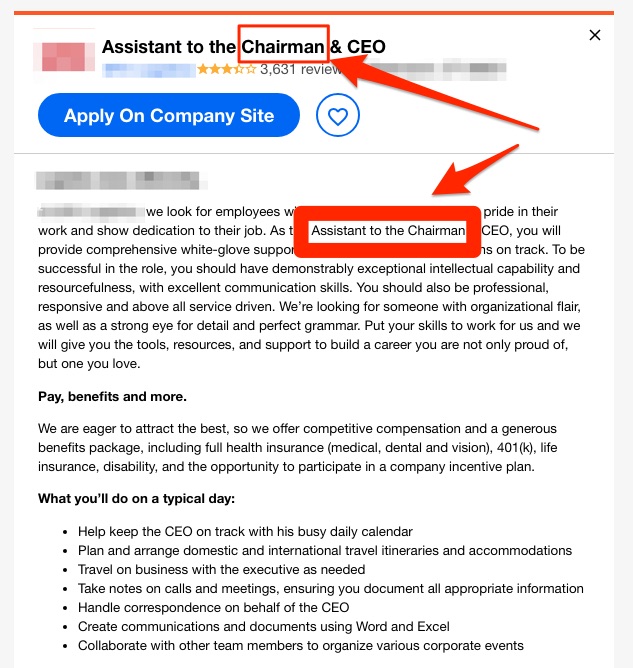
The use of “Salesman” would be another example (“Salesperson” or Sales Rep” would be better alternatives).
It’s amazing that so many masculine job titles still exist. Do you have any?
To double-check, check out Gender-Neutral Suggestions for the Top 25 Job Titles that still Use the Word “Man”.
2. Unconscious Gender Bias
The 2 main types of gender bias in job descriptions are:
1. Words proven to turn off some women or men
Certain words have been proven to attract or repel some male and female candidates, according to the Journal of Personality and Social Psychology’s Evidence That Gendered Wording in Job Advertisements Exists and Sustains Gender Inequality and other studies.
For example, Ongig’s Text Analyzer software (below) flags one such word “aggressively” as masculine in this job description for a made-up company called Bitcoin Inc.). In this case, some women feel the word “aggressive” is masculine and might suggest the company advertising the job has a male-oriented culture.
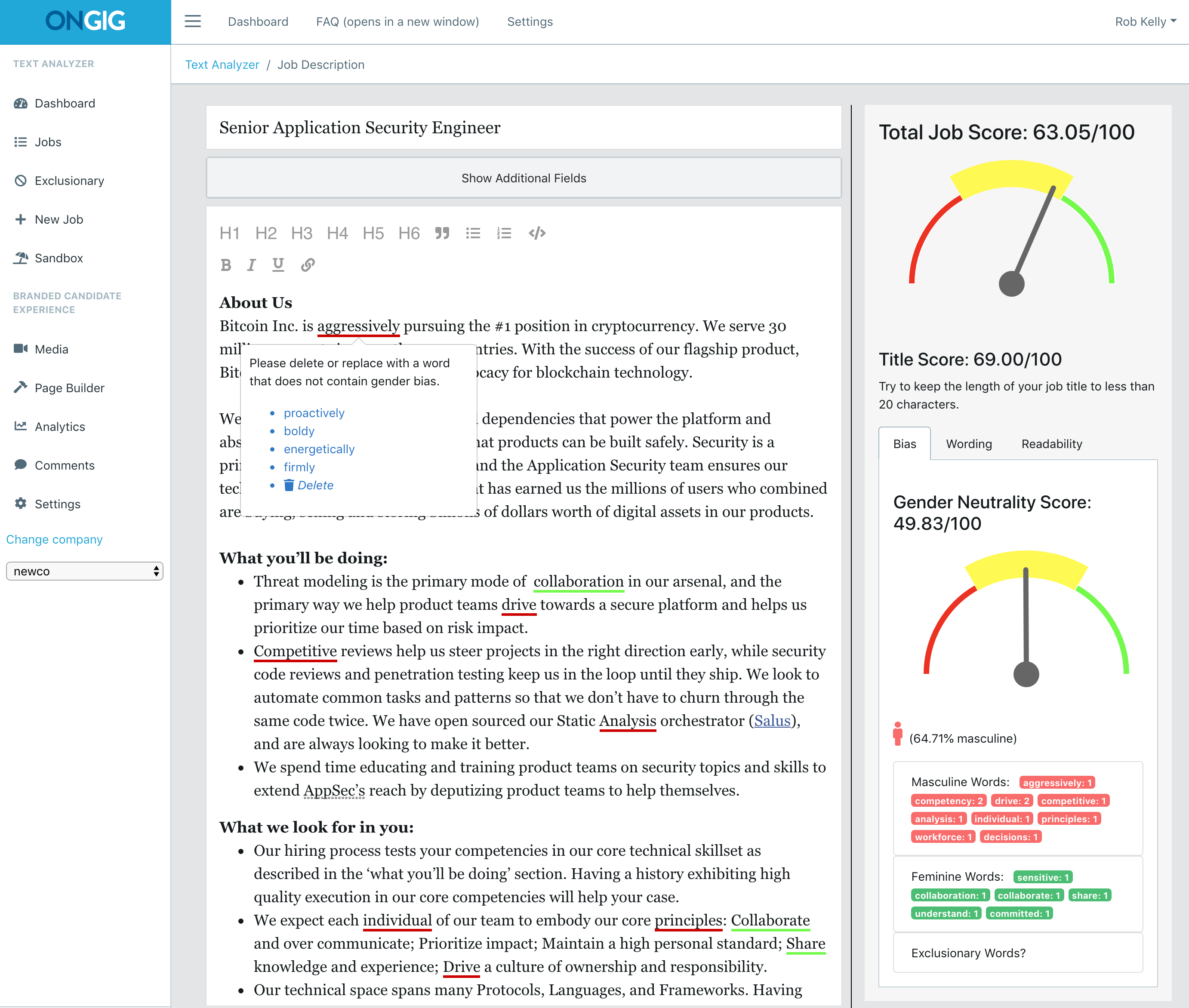
2. Gender Bias in Everyday Words
Some words are so ingrained that we hardly think about them.
A few examples:
“Guys”
Most people use the phrase “guys” in everyday conversation including in job ads (see below). Try to avoid using “guys” and instead sse “people” or “folks” or “team” or something more gender-neutral.
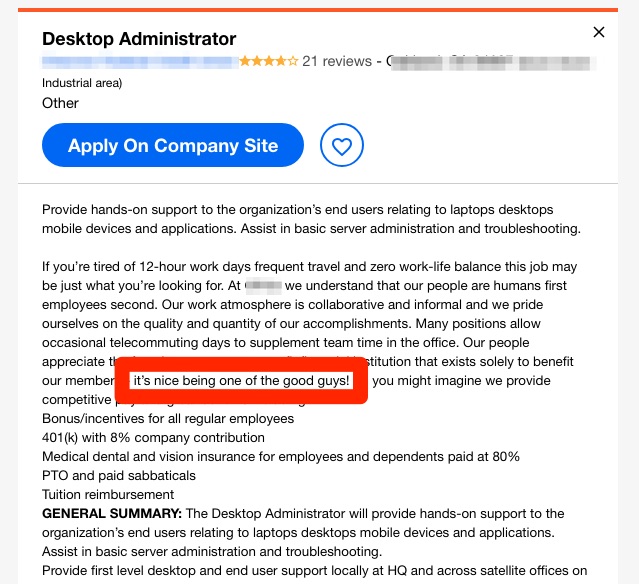
“Workmanship”
Check out the Custom Care Rep job does below. It says to some that you’re biased towards hiring men (and not women).
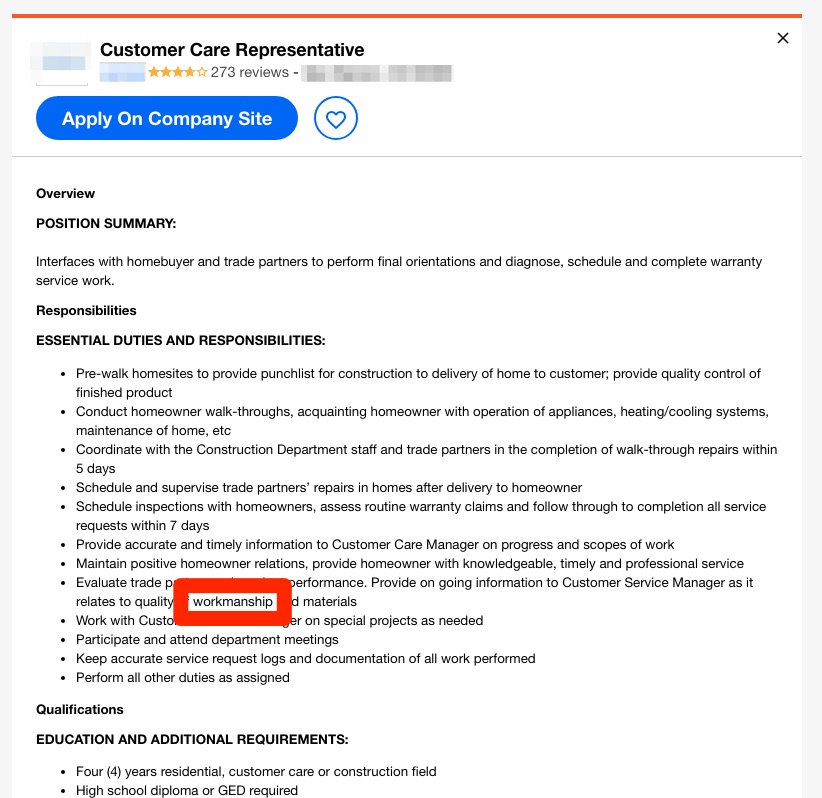
“Grandfather” — The employer below would be better off using the phrase “Legacy Clause” rather than “Grandfather Clause”.
The term “grandfathered in” in a job posting can imply unconscious bias. It suggests that someone who meets those old requirements can keep the job, even though they wouldn’t qualify according to today’s hiring standards. It unfairly disadvantages suitable candidates who wouldn’t have been excluded under the old system.
It’s also not clear what qualifications are actually necessary. This lack of transparency can discourage qualified applicants from even applying.
Seeing a position designated as “grandfathered in” can be demoralizing for other employees who may have worked hard to develop the skills now required for the job. It sends a message that their efforts are less valued than those of someone who meets outdated qualifications.
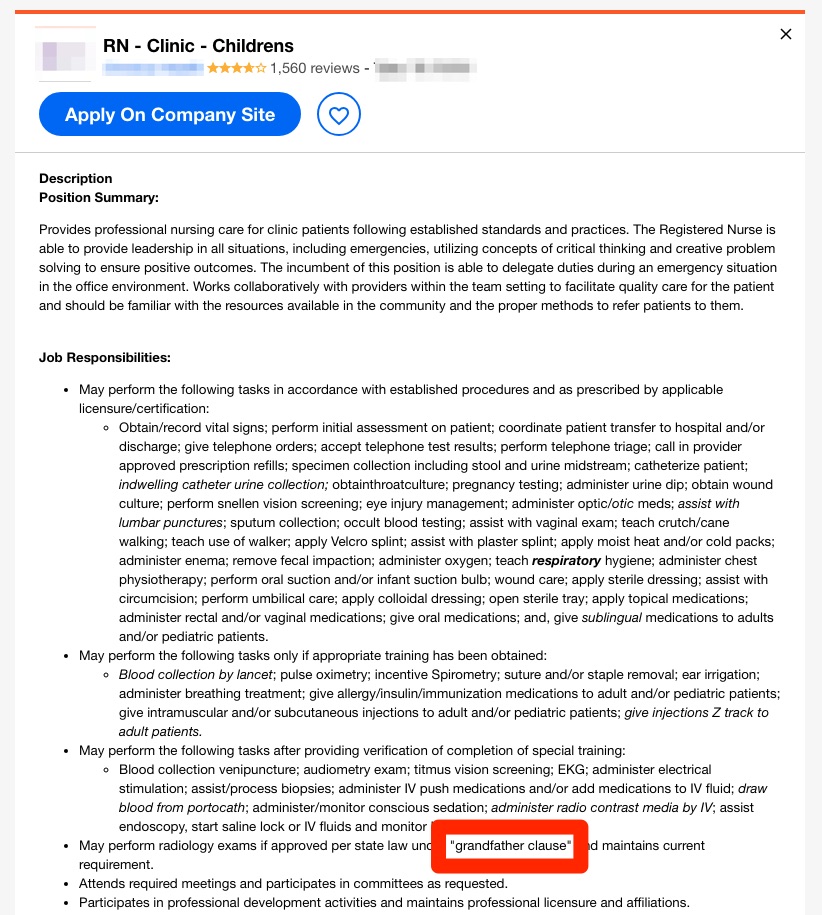
Assuming Spouses are Wives/Female
The government department below uses masculine-biased language in a job ad I’ve highlighted. They would be better of using language like:
“veterans and/or their spouses” or “veterans and their partners”
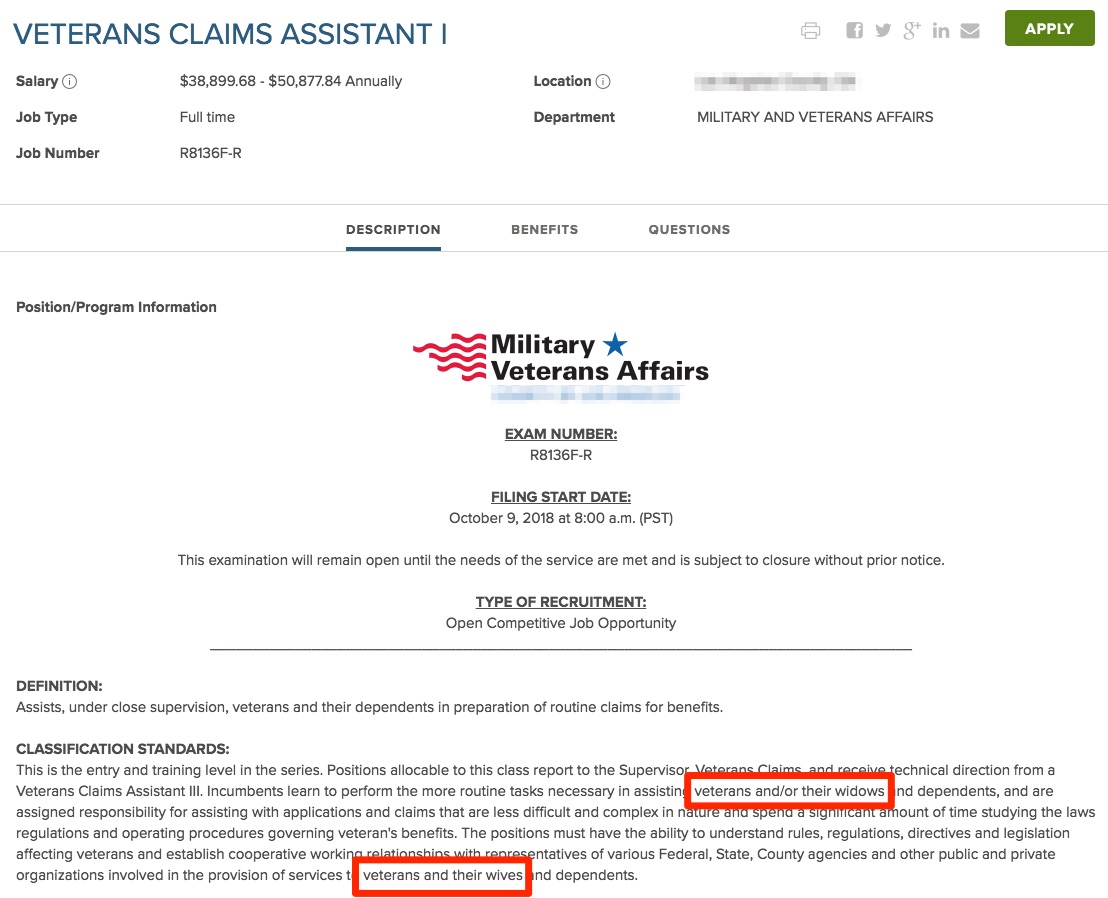
Check out The Top 10 Masculine Biased Words Used in Job Descriptions for the most common masculine word culprits!
And, if you want to have me/Ongig audit a higher volume of your job descriptions for gender bias, go to Text Analyzer and request a demo. We’re happy to give you a freebie.
3. Unconscious Racial Bias
Here are 2 examples of racial bias in job descriptions:
Example 1:
The cable company below is trying to be cute in their job ad by referencing the terrific movie Driving Miss Daisy (the movie in which an African American chauffeur drives around an older white woman). Wikipedia described the plot of that movie:
Some people who identify themselves as African American or of dark skin, might be offended by the “Driving Miss Daisy” reference.
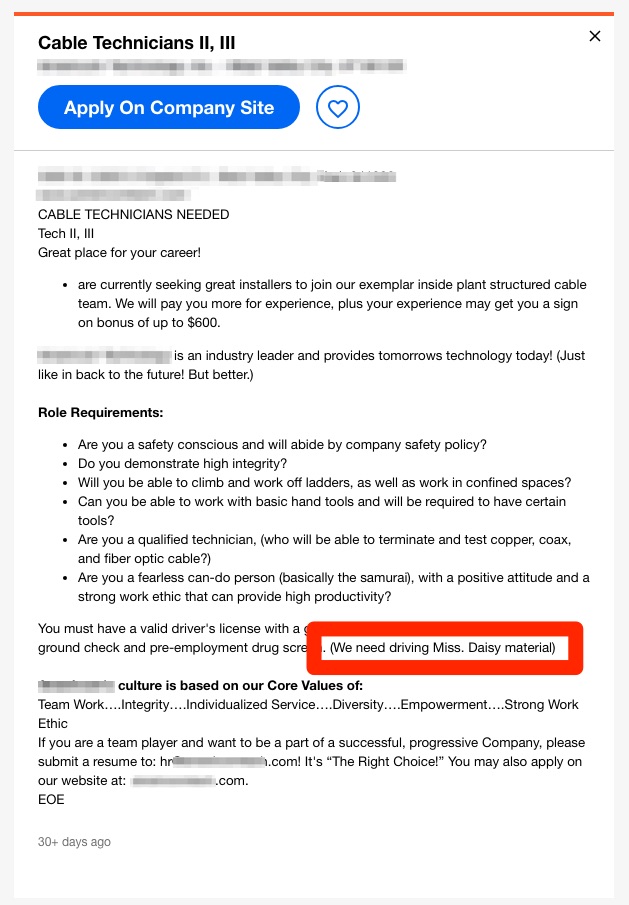
Example 2:
The phrase “Master/Slave” (see below) is used in many database-related job ads. It’s a type of software architecture.
But it’s a bad move.
The Global Language Monitor named this “the most politically incorrect term” of all of 2004.
Consider different language. For instance, tech leaders such as IBM, Microsoft, Amazon Web Services and others have replaced the use of “master/slave” with “primary/replica”

Example 3:
There are reasons why using “culture fit” in your job postings can be viewed as discriminatory.
First, it’s easy for recruiters to unconsciously favor job seekers who remind them of themselves or people they already know. This leads to overlooking qualified candidates from different backgrounds or work styles.
‘Culture fit’ can usually highlight personality traits or communication styles that aren’t critical to the role. These traits are inborn and can’t be changed.
And, hiring people with similar backgrounds often leads to homogeneous groups.
A lack of diversity can halt creativity and opportunities.
Instead, look for candidates with different perspectives and experiences to create a more well-rounded and effective team. Use behavioral interview questions that assess how a person handles a certain work situation to evaluate someone’s fit for the role objectively.
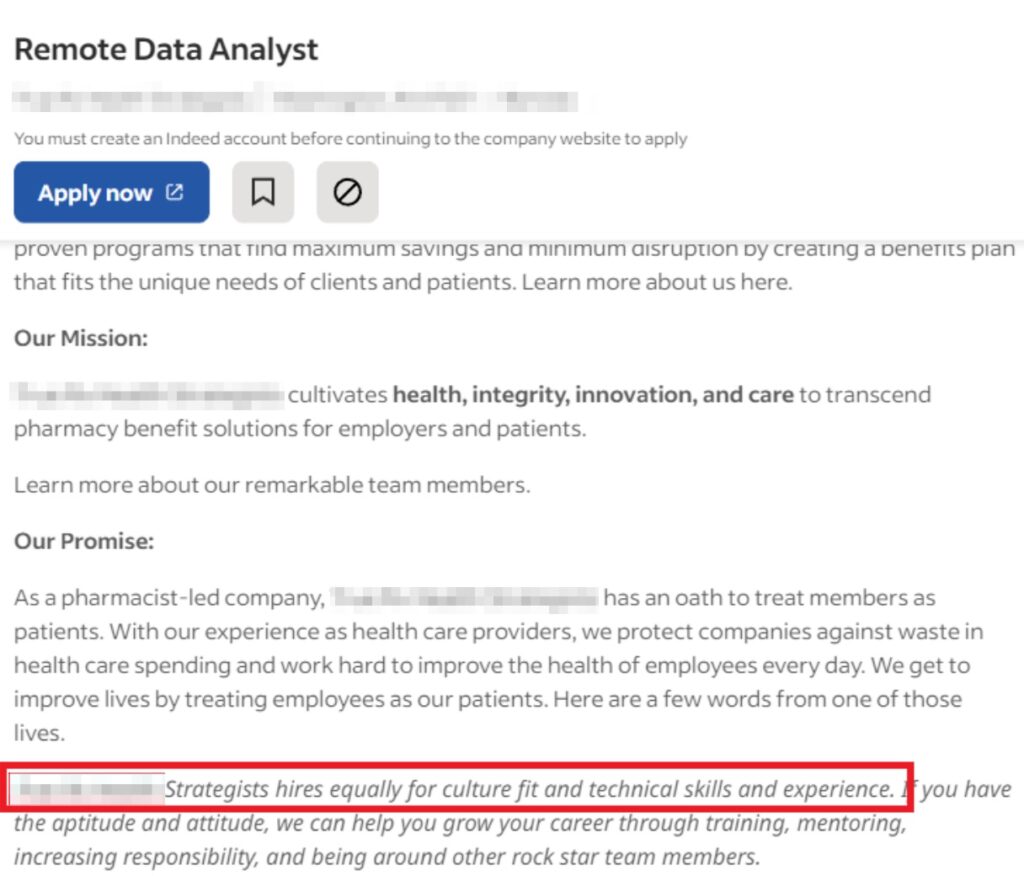
EXAMPLE 4:
Demanding a “native speaker” might exclude highly qualified applicants with excellent English language abilities who weren’t born in an English-speaking country, creating unnecessary barriers for qualified applicants.
Instead, you can describe the required fluency level. You can also specify the necessary skills (e.g., strong written and verbal communication skills and presentation ability). Or mention if there are specific tests required to demonstrate language proficiency. Focusing on the skills needed for the job can attract more qualified candidates and avoid potential discrimination claims.
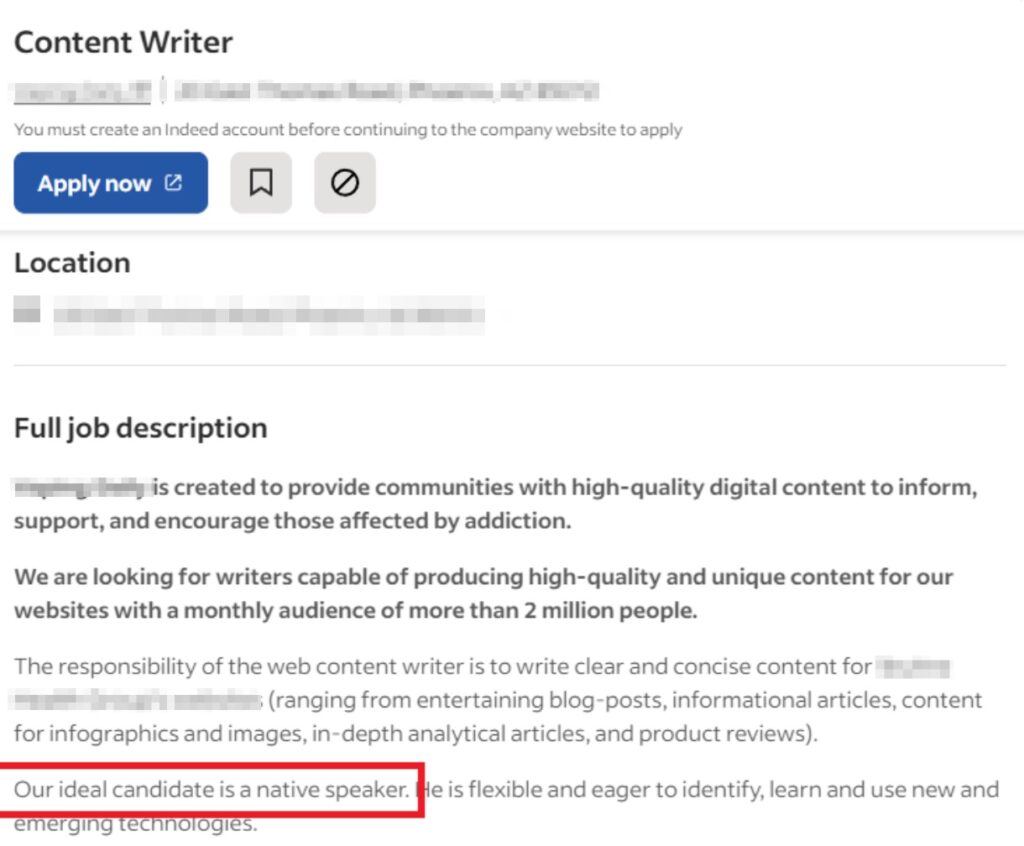
4. LGBTQ Unconscious Bias (“Personal Pronouns”)
It used to be that you covered both your bases if you used “he/she” and “his/her” language like the job description below.
No more.
Now, if you want to be inclusive, you’re best off using “they/their” language. Check out the example below. Ongig’s Text Analyzer flagged the “his/her” language and suggests alternatives like “their” or “you”.
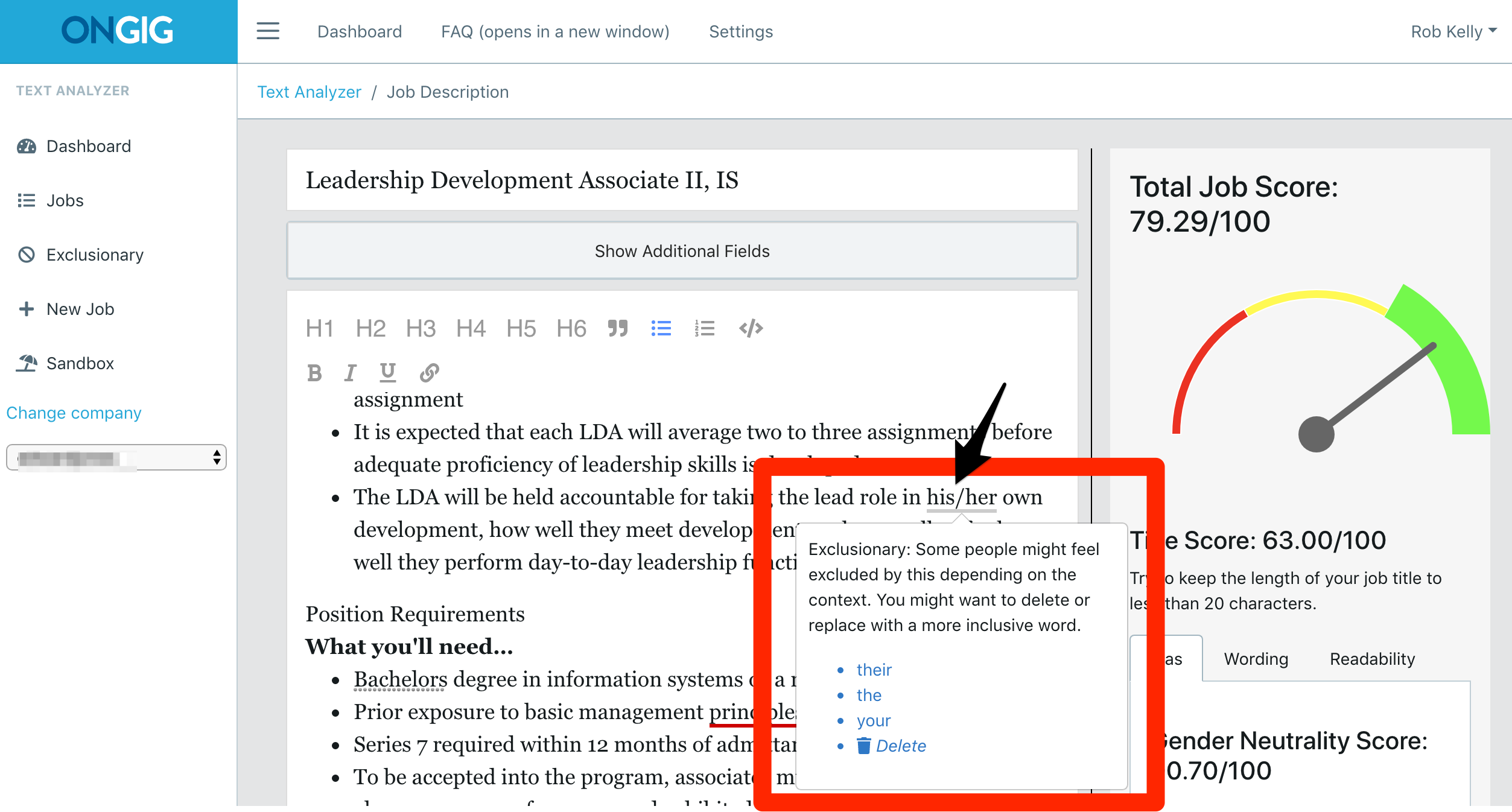
That way you’re including someone who doesn’t identify as a him or her.
Check out 5 Easy Ways to Remove LGBTQ Bias from Your Job Descriptions for more on LGBTQ unconscious bias.
5. Unconscious Bias: “Maternity”
Many employers continue to use the word “Maternity” in the benefits section of the job descriptions. The definition of maternity is “motherhood”.
When you use the term “maternity” you are excluding any candidate who might want time off related to having a child (even though they are not a “mother” (e.g. a husband, a father adopting someone or someone who identifies as neither a mother or father (e.g. a transgender person). Note: For more on Transgender/LGBTQ bias, see “LGBTQ Unconscious Bias” above).
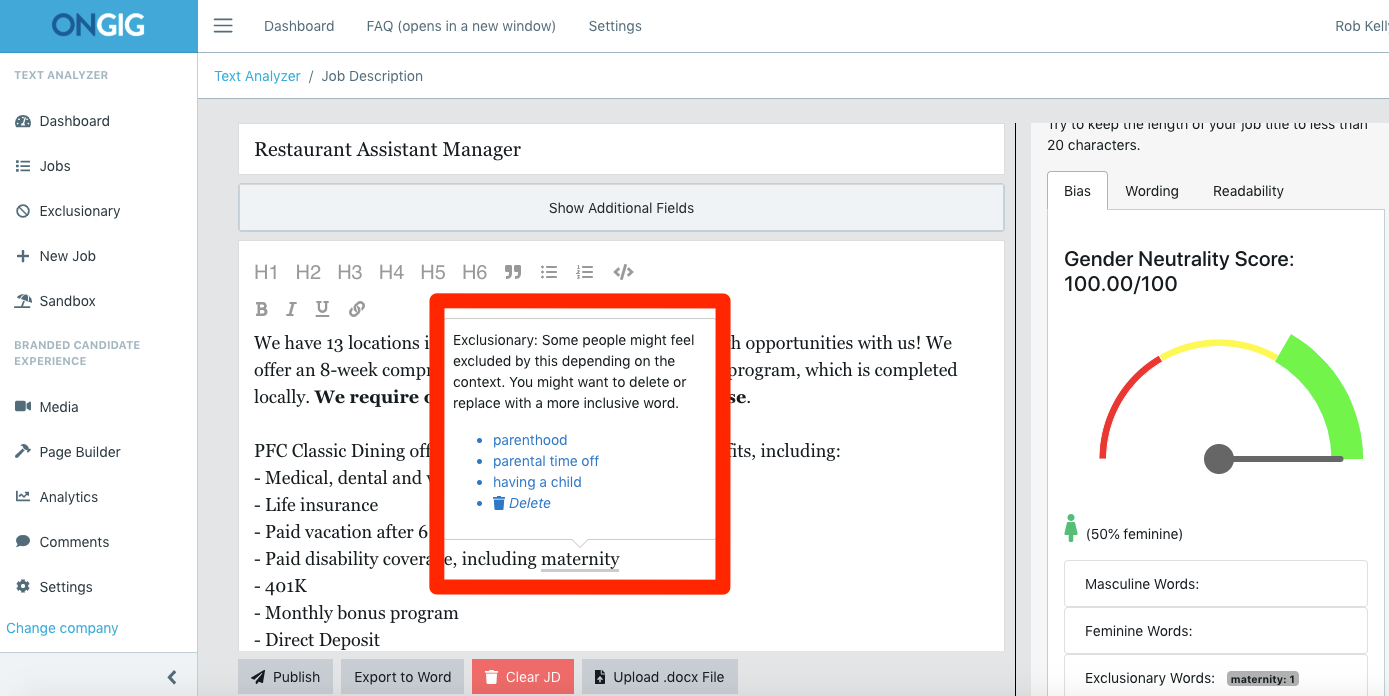
More progressive/modern companies are using alternative words and phrases for “maternity” such as:
- Parental time off
- Parenthood
- Having a child
You might ask:
“What about if my company provides time off only to mothers (and not fathers or someone who is transgender?”
You’re still better off using phrases like “parental time off” or “having a child” so that you are inclusive to all groups with your language (even if your actual benefit is not inclusive yet).
6. Disability & Unconscious Bias
There are numerous words used in everyday language that turn off someone with (or close to someone with) a disability.
- “speak” (“communicate” is better)
- “see” (“identify”, “assess” and “discover” are better)
- “carry” (“move” is better)
- “walk” (“traverse” is better)
Here’s one classic example that Ongig’s Text Analyzer caught:
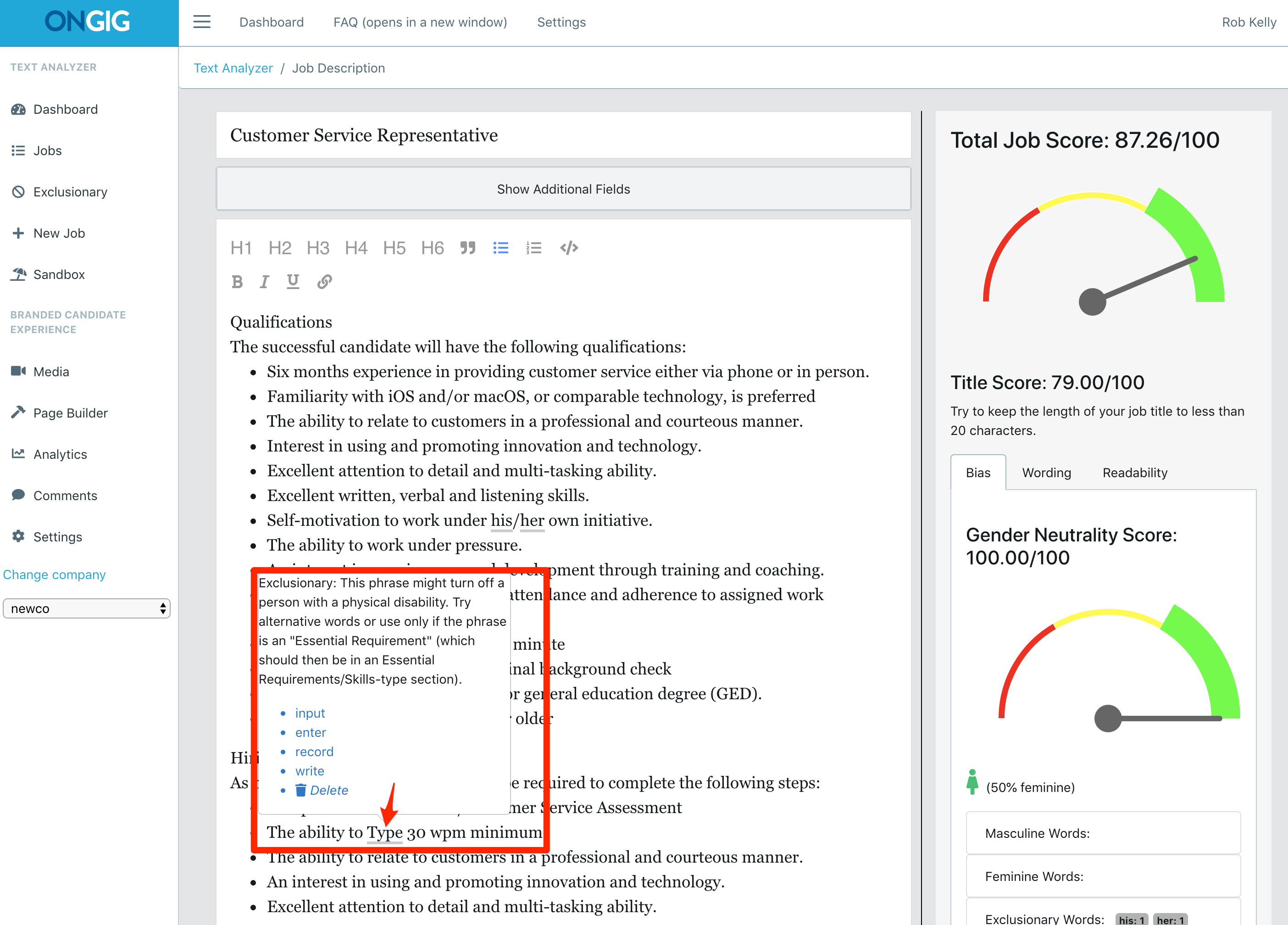
The writer of the above job description uses a common requirement about the candidate needing to “type” at least 30 words per minute.
But the word “type” implies that a candidate (or people they know) have hands. What if the candidate (or someone they know) inputs data into their computer using their voice?
This bias against people with disabilities is also called ableism.
If you want to be inclusive to candidates (and their loved ones) who might have a disability, check out 10 Tips for Recruiting People with Disabilities in Job Descriptions.
Example 1:
In the example below, it mentioned the employer requires the candidate to be:
“able to lift and carry merchandise weighing up to 60 lbs”
“able to push utility carts up to 60lbs”
While it’s okay to outline the physical requirements, they should be limited to the role’s essential functions. If some of these tasks can be reasonably performed using assistive devices or alternative procedures, they shouldn’t be dealbreakers.
Instead, you can use a more inclusive language. Instead of saying, “must be able to lift 50 lbs”, you can rephrase it to say “ability to move materials up to 50 lbs, with or without assistance”.
Synonymous to move, you can also use words like “install,” “operate,” “manage,” “puts,” “places,” “transfer,” or “transport.”
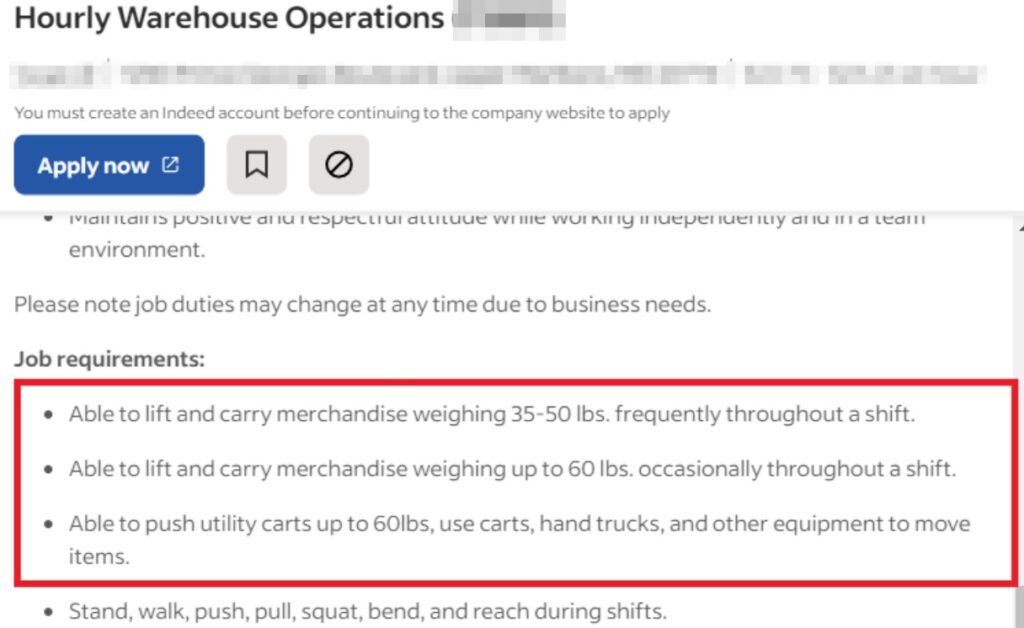
Example 2:
Listing basic human abilities like seeing, hearing, and speaking can be insensitive and discouraging to candidates with disabilities. It can raise a red flag for qualified applicants who use assistive technologies and can perform the job well. The phrasing “with or without reasonable accommodation” emphasizes limitations rather than accomplishments.
Instead, you should describe the specific communication, mobility, and technical skills needed to perform the responsibilities of the Enrollment Services Advisor position. You can also be more inclusive by encouraging applicants with disabilities to inquire about reasonable accommodations.
You could rephrase it by saying:
“The Enrollment Services Advisor will need excellent communication and interpersonal skills to answer questions and assist students effectively. This involves using a phone, computer, and light bending and reaching.”
“We are committed to creating an inclusive workplace and welcome inquiries about reasonable accommodations for job duties.”
This revised approach highlights the required skills for the job and clearly states that applicants with disabilities are welcome to apply.
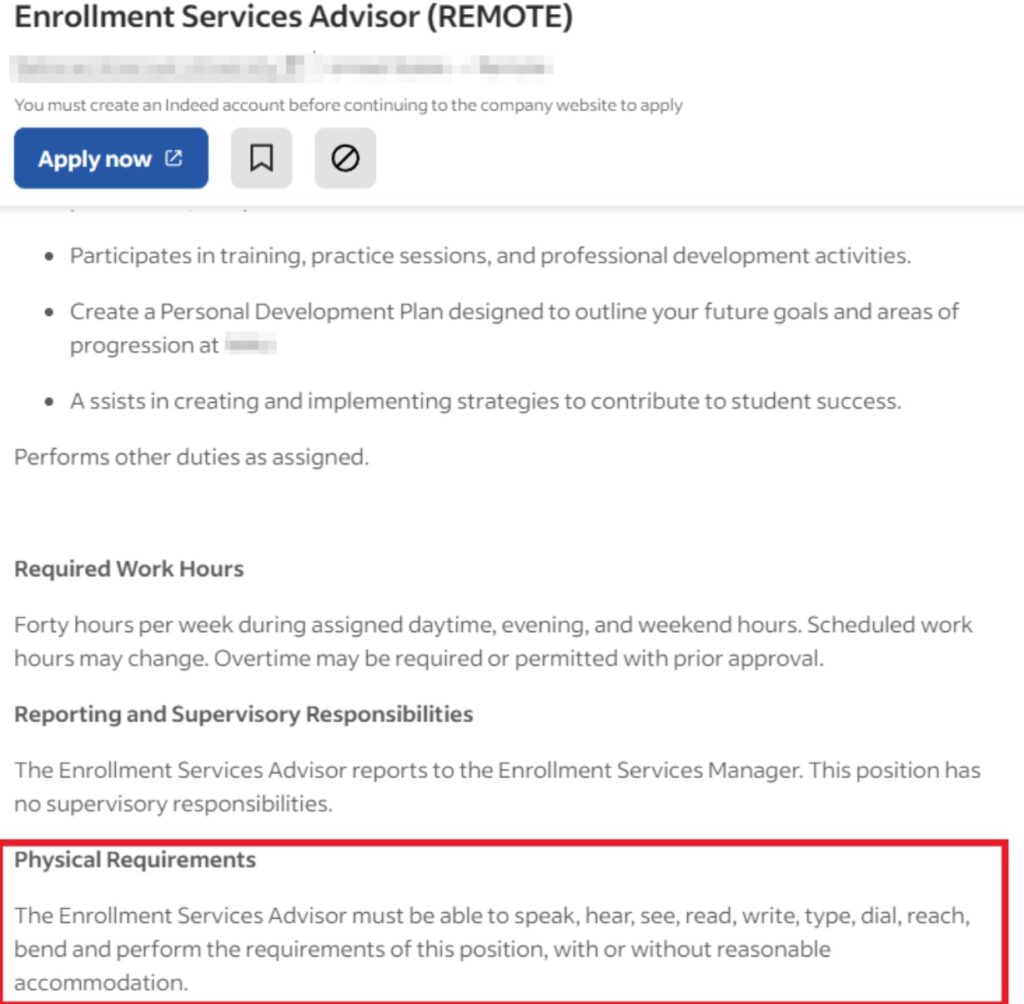
7. Unconscious Bias on Age
A single word or phrase could not only turn off older candidates but also get you bad HR or even sued. Google had been sued 227 times for age discrimination.
Below are a few examples:
1. Words like “Young” and “Digital Native”
Words like “young” are problematic. So is “digital native” as it suggests you only want to hire someone who’s grown up in the computer/Internet age.
Tip: Instead, try spelling out the skills you need (“familiarity with video games” is better than “digital native”).
2. “RECENT COLLEGE GRAD”, “ROCKSTAR,” “ENERGETIC,” “NINJA,” or “YOUNG” COULD BE AGE BIAS
If your job ad mentions wanting a “recent college grad” or needing someone “young and energetic”, you could get slapped with an age discrimination suit.
For example, if you put ‘looking for a digital marketing rockstar’, it may promote stereotypes about certain demographics, like assuming that only young people can excel in fast-paced environments.
3. “Years of Experience”
Dale E. Kleber, a 59 year-old with 25 years of experience, sued CareFusion in 2014 because their Senior Counsel job description stated:
“3 to 7 years (no more than 7 years) of relevant legal experience”
Kleber was not granted an interview and sued CareFusion under the Age Discrimination Employment Act (ADEA), 29 U.S.C. §§ 621-634.
4. What You Leave Out of a Job Description Might Get You Sued
If, for example, you fire an older worker for not being savvy at social media, you’d be better protected if your job description had mentioned: “social media expertise required.”
Whether any of this language is lllegal or not is not the only issue. Even if you the employer wins the case, it can end up being horrible PR for you and legally expensive (Google paid $11 million for their recent set of age bias lawsuits).
For more tips on unconscious bias of age, chek out 6 Ways to Avoid Age Bias in Your Job Descriptions.
8. Elitism & Affinity Bias
What is Elitism or Affinity Bias. As we reported in Elitism in Hiring: Who Needs Harvard?, it’s the belief that people with high education, high intellect, etc. are more likely to succeed than others.
Some people also call this “Likeability Bias” (i.e. I am attracted to others who are “like” me).
However, there’s evidence that elite schools do NOT produce the most productive workers:
See Who Needs Harvard? about the research data from Alan Krueger and Stacy Berg Dale or Indeed’s top school grads don’t outperform their peers in the workplace.
So, you might think twice about writing this type of requirement (see below) in your job ad:
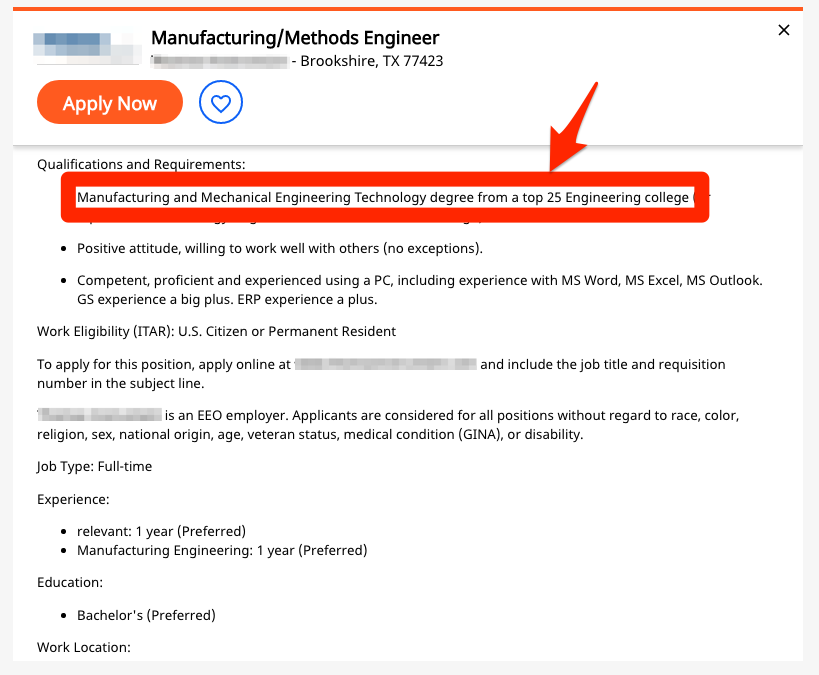
GPA BIAS
Some universities have stricter standards than others, so a high GPA from one school might not be equivalent to a high GPA from another. Also, students from low-income families or those working while attending school may not have the same means to achieve a high GPA as their non-working counterparts.
Additionally, GPA may not be a strong indicator of future job performance. A GPA does not necessarily reflect many skills and qualities important for job success. For example, a candidate with a high GPA may not be strong in numbers or have great teamwork skills.
When crafting your job descriptions, you should focus on the most important qualifications for the job you are trying to fill. Use skills-based evaluation to help you identify applicants with the skills and experience you seek, regardless of their GPA.
Be open-minded when considering candidates with essential industry skills, even if they don’t have a college degree. There are many ways to gain knowledge, not just through traditional education.
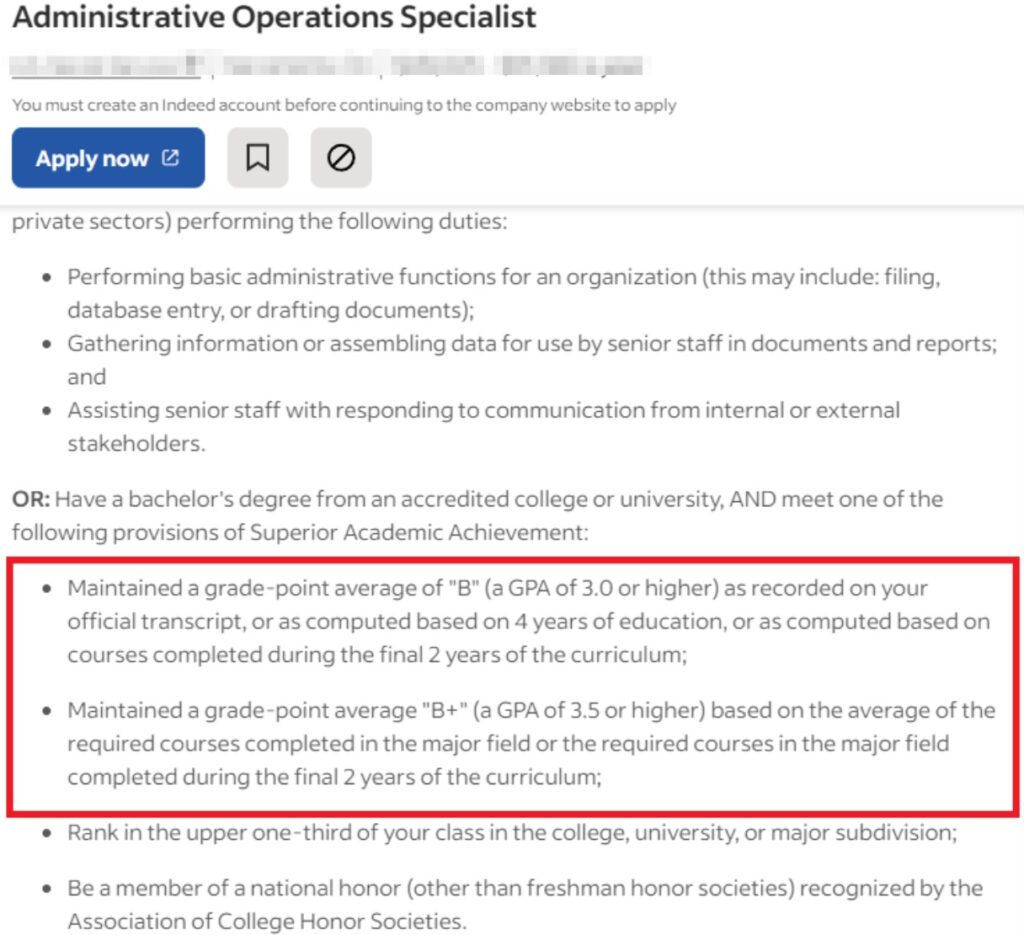
RELIGION BIAS
Religion bias in job postings is discriminatory because it excludes qualified candidates from other religions. You’re missing out on a pool of talented individuals who could be a great fit for the position by mentioning a religious preference. It also violates the anti-discrimination laws. In many countries, there are employment laws against religious discrimination, which include in a posting religious requirements in your job ad.
And, religious bias fosters a culture of exclusion. When a job posting mentions religion, it can send a message that only people of a certain faith are welcome. This can make qualified applicants from other religions, or agnostic or atheist candidates, feel unwelcome and discouraged from applying.
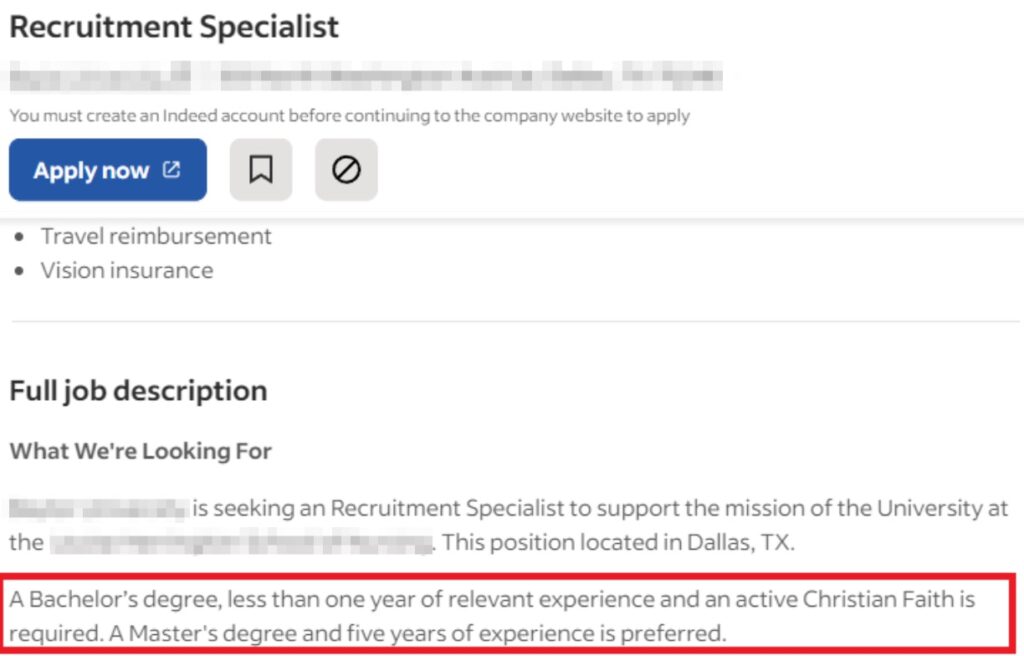
Note: A lot of the examples of unconscious bias above are gender-related. If you’d like to see more examples of non-gender unconscious bias, check out A List of Offensive (Exclusionary) Words Used in Job Descriptions.
Why I wrote this?
Ongig’s Text Analyzer software helps eliminate unconscious bias from your job descriptions. It finds offensive/exclusionary words and gives you recommendations to replace them. I’d be happy to analyze your jobs to show you examples of unconscious bias. Wouldn’t you prefer to find any bias before your candidates do!?
